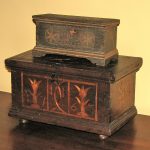We may receive a commission when you use our affiliate links. However, this does not impact our recommendations.
 ARTICLE: Read about Seaton’s tool chest.
ARTICLE: Read about Seaton’s tool chest.
From the August 2011 issue #191
Buy this issue now
The most prominent piece of furniture in my mom’s living room is a Queen Anne lowboy my dad built. As you can imagine, the piece is coveted by family members, as it was the first piece he tackled as a furniture maker. Dad had experience in home construction, but was new to furniture making. Right out of the gate he chose cabriole legs and a carved fan – that’s the way he approached woodworking and life.
The lowboy has highly shaped cabriole legs with an odd pad foot, yet they were made exactly as drawn in the plan from which he worked. As a newbie, dad called the legs “caribou” only to later find out the word was really cabriole. The mispronunciation was an inside joke that we laughed about many times throughout the years.
As dad’s first foray into carving, the lowboy’s center drawer has a fan that’s both simplistic and crude. He bought the needed carving tools then went at the fan straight on. I don’t know how many tools he bought, but he wasn’t one to make unnecessary purchases.
As his carving experience progressed, the number of tools in his possession increased. Upon his passing, he had collected 42 carving tools, a collection he housed in a three-level, construction-grade plywood box.
Because I’m the only woodworker in the family (though one brother dabbled at woodworking for a while), the carving tools were passed to me. Of course, I would have fought for those tools if need be because each time I use them I think about dad and the times we worked together, including for an article in the February 2000 issue of Popular Woodworking (#113). The article’s opening photo shows the two of us in front of a couple stepback cupboards. The caption began, “Quite a pair …” I consider that a compliment.
People store cherished items in special places. As woodworkers, those places tend to be fancy boxes built with our own hands – the more decorated the box the better, if history is any indication. Because dad’s carving tools deserve more than an ordinary plywood box, I set about to design an appropriate chest. After numerous iterations, I arrived at a design I felt was worthy.
The chest isn’t a reflection of its proposed contents. It’s not adorned with fans, shells or acanthus leaves created with the tools to be stored inside. No, my design is Federal in appearance because that’s the style that, today, captures my interest.
Attributes of the design, such as the three ovals on the chest front, mimic dad’s use of the three plywood trays. That, along with a few other personal reminders, make this chest important to me. I look forward to building the project in the solitude of my shop – just me and the memories. I look at this chest as my contribution to dad’s collection. Would this be a design he would have chosen? Probably not. He was OK with the plywood.
In August, I’m teaching a week-long class at the Connecticut School of Woodworking. This chest is the class project, so I intend to take my chest, filled with dad’s carving tools, with me. I’ll add a few tools along the way, sharpen away steel from his tools, and maybe, when the chest and its contents are passed to the next generation, I’ll be able to pass along memories of dad. That’s how woodworkers live forever. PWM
Here are some supplies and tools we find essential in our everyday work around the shop. We may receive a commission from sales referred by our links; however, we have carefully selected these products for their usefulness and quality.







